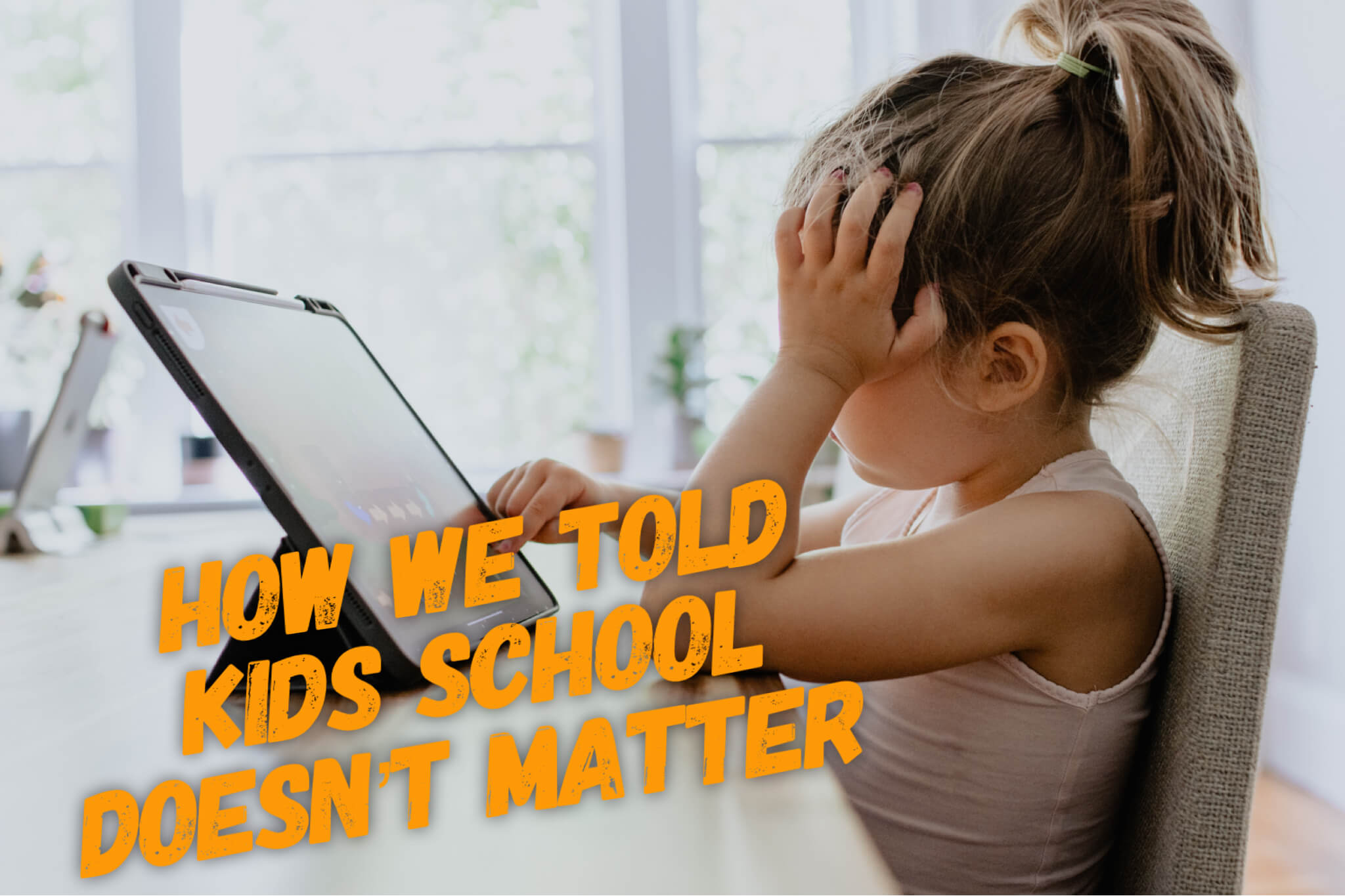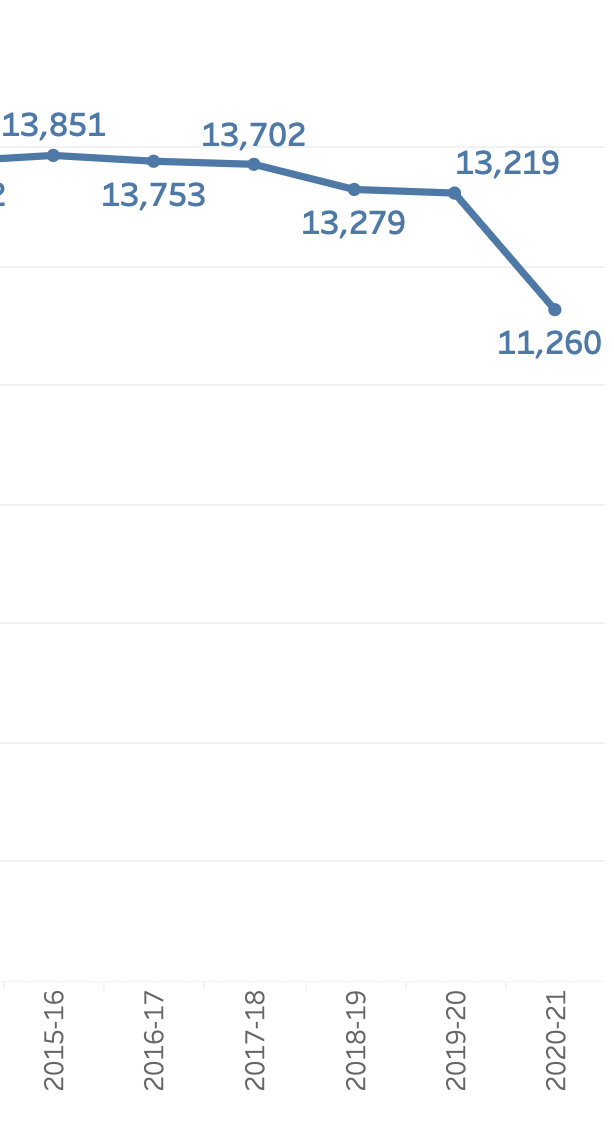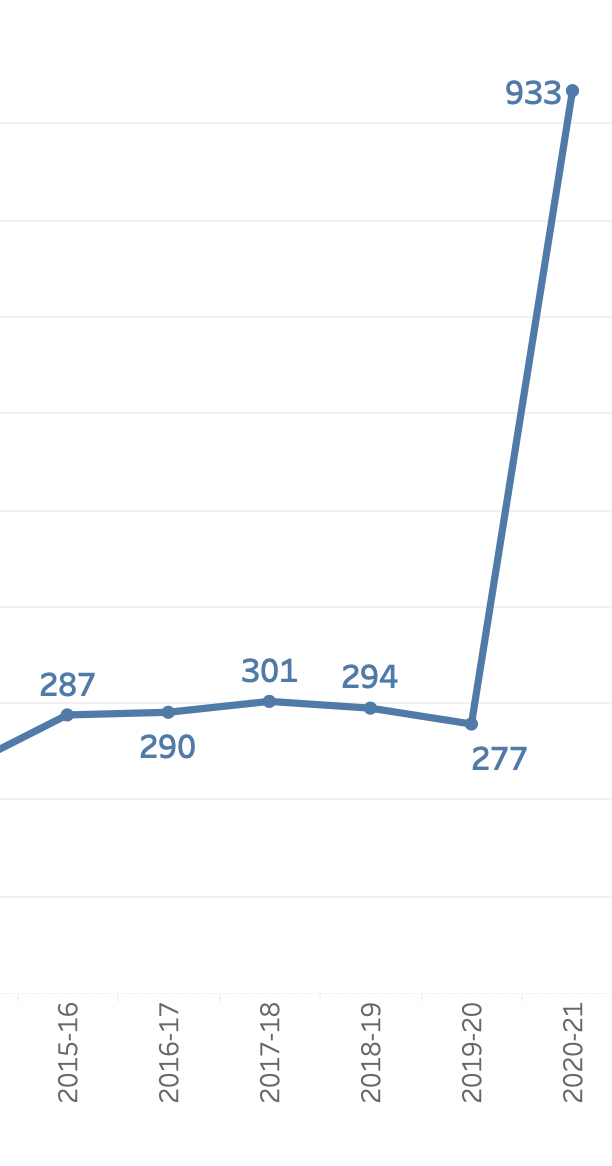How we told families school doesn't matter and what we can do to fix it.

We made a grave mistake in telling families that much of what we do in education doesn’t matter.
Well, nobody got on top of a building and proclaimed that education doesn’t matter.
But we did do things that communicated that very belief, even though we didn’t intend to.
We froze grades, communicating that grades are just made up anyway, and we can’t do anything to change that.
We closed schools, signaling that we don’t need schools to be open. Formal education is not important enough to withstand a pandemic.
We canceled tests that we have bullied families into participating in, and faced sanctions for not completing with a high enough participation rate, communicating that in all actuality, these tests don’t matter, but are just legislatively easy to impose on students.
We promoted every student, communicating that it doesn’t matter that you didn’t attend school for a significant portion of the year, in some places that was nearly half of the entire school year.
For virtual lessons, most teachers went right back to their main role being dispensers of information, communicating that aside from babysitting, their job could easily be done (and more effectively) by robots! More on this in an upcoming article.
We talked about learning loss, telling kids that all the things they learned during the pandemic were worthless because they weren’t done in our schools in our ways.
Rather than recognizing the learning that did happen, we just assumed that because they didn’t master what they would have in school, it didn’t matter.
Despite what could be considered our best efforts, and surely, most educators were doing the best they could with what they had, we still managed to signal to kids and families that this whole education system is a complete and total farce.
It only matters when everything is exactly how it needs to be for the system to work.
Aberrations from the system are discouraged, even when they are better for kids.
In fact, often, those who go against the system are run out of the system.
Just before the pandemic, there was a big groundswell effort to have more personalized learning. This was, in fact, the very BEST thing that we could have done to prepare for a global pandemic. We could have doubled down on personalized learning and made the experience that much better for our students. That we didn’t betrays the very real truth that most teachers don’t want to do that in the first place.
Although many teachers got masters degrees in education (completely online!) the learning they engaged in never actually made it back to their classrooms! Yikes! But I do know, emergency remote teaching is different than online learning.
Unfortunately, the actions we took we took when the pandemic started had dire effects.
Where can I turn for education?
In Fairbanks, Alaska, my previous school district, they saw a reduction in enrollment of 2,000 kids. From 13,219 to 11,260. This unprecedented drop did severe damage to a school district already experiencing sharp decline. That is 15% of the student population gone in one year. Source
 That’s a huge drop. That leads to reduction in staffing, as it is not sustainable to keep teachers and other staff on board when you have that many students leave your district.
That’s a huge drop. That leads to reduction in staffing, as it is not sustainable to keep teachers and other staff on board when you have that many students leave your district.
But where did they all go? Well, that district has a homeschool program that is supported by the district. Unfortunately, the district refused to allow people to transfer into the homeschool program at the time, as many families wanted. So, the enrollment in the homeschool program did increase, and significantly, by over 300%!!! But that 2000 student decrease in the district does not count any students enrolled in the district homeschool program as they stayed in the district. So, the actual decrease of students in physical schools is about 2600! That, again, takes it toll.

What Alaska has going for it is that families that enroll in homeschool receive an allotment, usually between $2,000 and $2,500 per student. But the district still receives the base student allocation given to a district for each student enrolled.
Where Fairbanks made the mistake is in not allowing students to transfer into their homeschool programs. While I don’t have data to cite, I’ve heard that homeschool enrollment is up across the state.
This is beyond just Alaska, Los Angeles Unified lost nearly 30,000 students.
Here’s the point of all this. When families have choices, they will take those choices.
And I see this as only continuing as parents are more and more reluctant to send their kids to “indoctrination camps” they believe are teaching their kids bad messages.
Public schools should embrace alternative options for education, which I call a Hybrid Education System
What we need more of now, is personalized Education, notice the capital E. It’s about changing our system to allow for learning from anywhere to be “credited”.
A Hybrid Education System
A Hybrid Education System is one in which Learning is the constant and time and location are the variables.
Let’s take a less than hypothetical example:
Daniel works in public education, but it’s just not working for his youngest son, TJ. TJ has been to a few years of public school, but it seemed that the curriculum and way they do school work at the local private christian school would work better for him. So, Daniel enrolls TJ in his local district-supported homeschool program, and then pays out of pocket for him to attend the Christian school. He receives an allotment, which cannot be used for faith-based curriculum, but works with the teacher to ensure that they are following state statutes relating to faith based education.
Now, TJ is still connected to the district, the district is still getting money from the state for TJ’s enrollment, and the parents are able to get TJ the learning environment they feel will best support his personal growth and development.
What we need are for school districts to take an active interest in the education of every child in their boundaries. That doesn’t mean that the district is in charge, or that they have any say on what goes on.
It’s a service oriented mindset. How can we serve your learning?
A little known fact about the Church of Jesus Christ of Latter-day Saints, of which I am a member is that we believe that our lay leaders have a responsibility to serve anyone who lives in their geographic area. You could say, we have an interest in the spiritual growth of every human who lives in our geographic areas.
That doesn’t mean that we go to other churches and tell them how to live their religion. It means that if someone needs something from us, we will gladly answer the call.
Public school districts should take a similar approach. They needn’t be bossy or overbearing, but should be eager and ready to serve the educational needs of the students living in their boundaries.
What would this look like?
First of all, if a student is enrolled in a competitive sport outside of school, it may mean that the school doesn’t need to provide physical education, or that it could endorse a different model that would be more beneficial to competitive athletes.
At the extreme example, it could be a student is enrolled in a private school and they have no contact with the district.
And everything in between.
Here are a couple unique situations that should be not just allowed, but actively pursued by schools.
I’ve had several students that are gifted artists. Thankfully, they have sometimes had gifted art teachers. But sometimes, the student’s skill has surpassed that of the art teacher. And certainly, the art teacher’s curriculum did not meet the needs of the gifted students. Alternatively, I’ve had students who just wanted to learn watercolor and so took classes outside of school for that.
This example is about art, but art can be conveniently replaced by just about anything families get private tutors for: math, music, dancing, horse riding, etc.
A big problem these “private” teachers ran into is that kids could only do lessons after or before school.
There are several ways to address this issue:
- Give students release time to go learn from someone else.
- Invite private teachers to come into the school to teach small groups or specific things.
- Allow students to have a space and time to do their work for private teachers on whatever they are working on
- Allow students to take virtual courses (think Lynda.com, udemy, Masterclass) on topics they are interested in where the public school teachers have no impact on those classes at all.
What all of this amounts to is school supporting students’ desires to learn and get education from whatever source it may be.
There’s an extra added benefit here, too. When kids are out of a regular class and are doing their own thing, it reduces the class size for the teachers.
Think about it this way. Let’s say this all fit neatly in a middle school day that I could expect to have 40 kids (10 percent of total population) involved in something else during each period. That would reduce my other class sizes (in the schools I worked in) by about 3 kids (because of the added flexibility). Three kids may not seem like a lot, but when you think of what Dickens said, “They were not forty children conducting themselves like one, but every child was conducting itself like forty” you see that it can feel like a lot less to a teacher trying to help her kids.
But, that won’t work because…
Issue: but those other sources are not vetted, and they don’t have credentialed teachers! A credential does not mean you know how to teach. It means you can navigate the increasingly bureaucratic maze necessary to obtain such a credential. In the Book, Believe in People, Charles Koch describes the plight faced by a low-income person attempting to start a business. “A 2018 study found that licensing prevents the creation of nearly two million jobs each year.” (Page 181, Location 2563)”
Issue: transportation and equity are concerns These are already concerns. Low-income families already don’t have access. When the school takes an interest in these kinds of things, they open the door to students who would not otherwise have access. Still a concern about how they pay for it, and w
Issue: Who is going to pay for all these additional teachers? Ideally, families would continue to pay for the services their kids are getting. But schools are great about finding ways to make it work. Local private teachers would likely be happy to pay rent for classroom use if they have a steady stream of students.
Issue: Teacher Unions don’t want to give up jobs to others In my scenario, there are no jobs given up, but just new opportunities for others. That doesn’t mean they have to be full time employees. The school district could easily contract with private teachers rather than hire them as full time or even part time employees when the situation arises that a school would actually pay for this for low-income students, but it’s certainly not a requirement and not something that has to be done.
Issue: **Who pays them and is liable when they come into the school? **
Issue: What about supervision when kids are working alone or need help Schools will need to plan for this. The idea is that kids would be working alone, and so supervision to ensure nobody gets hurt is probably all that is needed. They have private teachers to go to for help.
Issue: What about inappropriate communication with outside sources? We certainly want to save kids from the damage that can be caused by abusive situations. Unfortunately, inappropriate communication happens even with credentialed teachers, so it is vitally important to continue to protect kids. Supports, checks and balances, and wise procedures need to be implemented to ensure all kids are safe.
What other issues am I forgetting and what are your solutions to those issues? What doesn’t make sense?
Originally published on my substack
Notes mentioning this note
There are no notes linking to this note.